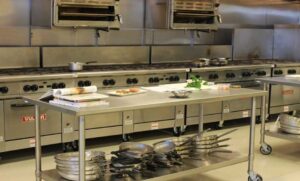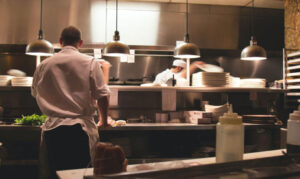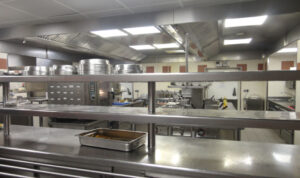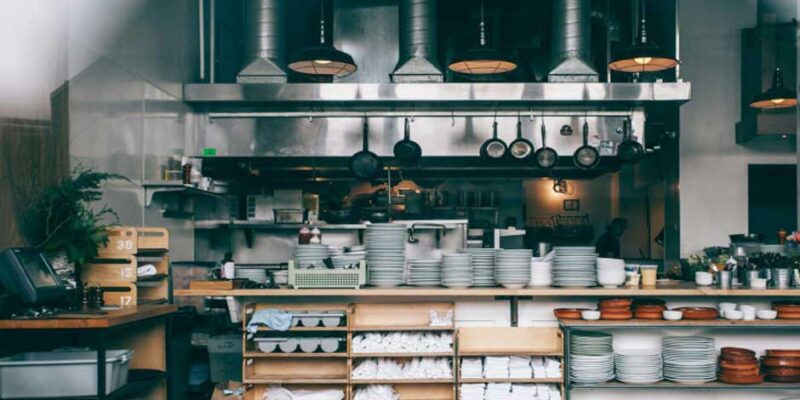Behind every unforgettable meal is a kitchen that runs like a finely tuned engine. Whether you’re a head chef launching your dream restaurant or a seasoned operator expanding your brand, your kitchen setup will either accelerate or stall your success. This guide is built for those who treat their kitchen like the heart of the business, not just the back of house.
A high-performance kitchen isn’t about shiny gear or squeezing more into tight quarters. It’s about designing with intention—where layout, equipment, workflow, and maintenance converge to boost efficiency, reduce error, and drive long-term profitability. Let’s break down how to build one, from the first sketch to the final service.
What Makes a Kitchen “High-Performance”?
A high-performance commercial kitchen is more than clean lines and chrome. It’s engineered for speed, safety, and repeatable excellence. What sets it apart isn’t the size or budget—it’s the intentional design that supports staff flow, equipment synergy, and real-time demands of the service rush.
At its core, a high-performance kitchen does three things exceptionally well: it minimizes wasted motion, protects food quality, and withstands relentless daily use.
Key characteristics of a high-performance kitchen include:
- Optimized workflow zones
- Durable and efficient equipment
- Energy-efficient systems
- Smart storage and layout
- Food safety and sanitation built into the design
This combination allows for seamless operations under pressure—whether you’re plating 10 or 200 meals per hour.
What Are the Key Phases in Setting Up a Commercial Kitchen?
Building a commercial kitchen involves more than installing ovens and plugging in refrigerators. Each phase must align with your restaurant’s goals, regulatory requirements, and long-term flexibility.
Here’s a breakdown of the major setup stages:
- Concept and business model alignment– Every decision should reflect your service model, whether fine dining, QSR, or delivery-only.
- Menu planning and needs analysis– Your menu drives your equipment and space needs—not the other way around.
- Layout design and zoning– Organize flow from storage to service, avoiding bottlenecks and backtracking.
- Equipment selection and sourcing– Choose machines based on volume, quality, and efficiency—not trend appeal.
- Plumbing, HVAC, and electrical setup– Coordinate utility plans early to avoid costly redesigns.
- Compliance, inspections, and certification– Ensure local fire, health, and safety codes are met before opening day.
- Staff onboarding and workflow testing– Run simulations and dry runs to identify operational blind spots.
Skipping or compressing any of these phases can lead to delays, compliance issues, or costly redesigns after launch.
How Should You Plan Your Kitchen Layout for Maximum Efficiency?

Your layout defines your efficiency, plain and simple. If your chefs are zig-zagging or reaching too far during rush hour, the design is broken. The classic kitchen triangle—storage, prep, and cook—is still foundational, but modern kitchens go beyond that with layout types tailored to scale, team size, and menu complexity.
What Are the Most Common Commercial Kitchen Layouts?
Each layout comes with trade-offs. Your decision should reflect your operation’s flow, staffing model, and available space.
- Assembly line– Ideal for high-volume, repeatable dishes. Great for fast-casual and cafeteria models. Lacks flexibility for varied prep.
- Island layout– Centralized cooking zone surrounded by support stations. Encourages collaboration but requires ample space.
- Zone-style kitchen– Divides stations by task (grill, salad, fry). Excellent for restaurants with broad menus. Can suffer from poor communication if not managed well.
- Galley layout– Efficient in tight spaces with two parallel lines. Best for small kitchens but can become cramped during peak hours.
- Open kitchen– Combines aesthetics with transparency. Increases guest engagement but demands spotless execution and higher acoustic control.
How Do You Define Functional Zones in a Commercial Kitchen?
Smart zoning reduces collisions and confusion. A well-zoned kitchen feels natural to navigate—even for a new hire.
Essential zones include:
- Receiving and storage
- Cold and dry storage
- Food prep
- Cooking line
- Plating and pass-through
- Warewashing
- Staff circulation and cleaning
Each zone should be clearly marked and flow logically into the next. Don’t underestimate the impact of a well-placed sink or the value of elbow room during a Saturday night service.
How Should Menu Planning Influence Kitchen Design?
The menu is your blueprint. Design without it, and you risk mismatches between equipment, storage, and station layout. A high-turnover kitchen cooking steaks, sushi, and pasta can’t operate efficiently on a single flat-top and one prep table.
Menu types and their design implications:
- À la carte– Demands flexible stations and rapid-fire prep access.
- Prix fixe– Allows streamlined, repeatable workflows.
- Fast casual– Prioritizes speed and compact assembly.
- Multi-course tasting– Requires precision stations and plating space.
Your kitchen should reflect the pace, variety, and volume your menu promises. Don’t make design decisions in isolation from your culinary identity.
What Equipment Is Essential for a High-Performance Commercial Kitchen?
Not all equipment is created equal—and not all kitchens need everything. The key is choosing industry-grade models that match your service volume and menu requirements, while keeping energy use and maintenance top of mind.
Cooking Equipment
Heavy-duty ranges, convection ovens, combi ovens, griddles, and fryers are staples. Look for programmable settings, energy star ratings, and quick recovery times.
Refrigeration & Freezer Units
Industrial glass door refrigerators, undercounter fridges, walk-ins, and blast chillers should be appropriately sized to avoid spoilage or overstocking. Door seals and temperature monitoring systems are critical.
Food Prep Equipment
Mixers, slicers, processors, and blenders save time and improve consistency. Choose stainless steel models for easy sanitation.
Ventilation and Hood Systems
Proper hoods regulate temperature, capture grease, and prevent fire hazards. Ensure CFM ratings match your cookline’s BTU output.
Dishwashing and Waste Management
High-capacity dishwashers with sanitizing cycles, compost bins, and grease traps streamline cleanup and regulatory compliance.
Smart Kitchen Technology (IoT)
Automated temperature monitoring, predictive maintenance alerts, and usage tracking help reduce waste and extend equipment life.
What Are the Best Materials for Commercial Kitchen Surfaces and Fixtures?
Surfaces in a commercial kitchen take a beating—hot pans, sharp blades, constant moisture, and cleaning chemicals. Choosing the right materials isn’t just about aesthetics. It’s a matter of food safety, durability, and ease of maintenance.
Common surface materials and their pros/cons:
- Stainless steel– Hygienic, heat-resistant, and easy to clean. Can scratch and show fingerprints.
- Epoxy resin– Durable and non-porous. Ideal for countertops and shelving, though it can be expensive.
- Ceramic tile– Affordable and heat-tolerant, but grout lines can harbor bacteria.
- Poly cutting boards– Non-porous and dishwasher-safe. Must be replaced when grooved or warped.
- Quartz composite– Visually appealing and resistant to stains. Not ideal near high heat zones.
Stick to materials that can withstand daily wear and comply with health codes. Avoid anything porous or prone to damage under heat and water.
What Codes, Standards, and Regulations Must Be Followed?

Ignoring compliance can shut your kitchen down before your first dish is served. Design with codes in mind—not as an afterthought.
Key requirements to address:
- Fire safety and suppression– Install UL 300-compliant hood systems and extinguishers.
- Ventilation– Meet local airflow and filtration standards to ensure staff and guest comfort.
- Health and hygiene– Design for HACCP compliance, including proper sink placement and food storage separation.
- Accessibility– ADA-compliant pathways, signage, and fixtures are mandatory in most U.S. municipalities.
- Electrical and plumbing codes– Ensure certified contractors follow local laws for all installations.
Work with a licensed kitchen planner or architect familiar with your jurisdiction to avoid costly retrofits or violations.
What Mistakes Should You Avoid When Building a Commercial Kitchen?
Even seasoned restaurateurs fall into avoidable traps when designing their kitchen.
Common missteps include:
- Underestimating ventilation needs
- Cramming too much equipment into too little space
- Failing to plan for cold and dry storage
- Skimping on dishwashing systems
- Ignoring future expansion or menu shifts
Avoiding these errors begins with planning for real-world use—not just blueprints.
How Do You Ensure Smooth Workflow and Staff Movement?
Movement should feel intuitive. Every step and reach adds up across a shift.
Workflow considerations:
- Place equipment logically along prep/cook paths
- Store ingredients close to their point of use
- Create open lines of sight and communication
- Ensure cleaning stations are within reach, not in the way
Design like a chef—not an architect—and you’ll notice the difference in every shift change.
How Can Design Support Food Safety and Hygiene?
Cleanliness shouldn’t be a reaction—it should be embedded into your layout.
Hygiene-supporting design elements:
- Seamless, non-porous surfaces
- Dedicated handwashing sinks
- Separation of raw and cooked ingredient zones
- Floor drains near wet prep areas
- Wall-mounted shelving for off-the-floor storage
Design your kitchen to be easy to clean, and it will be cleaned more often.
How to Train Staff for New Kitchen Systems and Equipment?
Even the best equipment is useless without skilled, confident staff.
Onboarding steps:
- Demonstrate correct equipment usage
- Teach cleaning and shutdown procedures
- Review safety protocols for each station
- Walk through workflow paths during prep
- Reinforce with posted guides and checklists
Build consistency early. Repetition beats chaos every time.
What Maintenance Practices Extend the Life of Your Equipment?
Preventive care is cheaper than emergency repairs.
Maintenance schedule:
- Daily– Clean filters, wipe down surfaces, empty grease traps
- Weekly– Inspect hoses, check refrigerator temps
- Monthly– Deep clean hoods, sanitize drains, inspect seals
Document everything. A clear logbook helps spot issues before they become problems.
How Do You Plan for Downtime, Repairs, and Emergency Service?
Downtime is inevitable. How you handle it determines how bad it gets.
Pro tips:
- Sign service contracts with responsive vendors
- Keep backup gear for critical tasks (e.g., countertop fryer)
- Train staff in SOPs for breakdowns
- Know your technician’s emergency contact hours
Anticipating problems is the hallmark of a well-run kitchen.
What Are the Best Vendors and Equipment Brands to Consider?

Don’t chase brand names blindly. Evaluate based on serviceability and long-term value.
Vendor selection criteria:
- Warranty length and terms
- Local service availability
- Third-party reviews from operators
- NSF and ENERGY STARcertifications
- Easy access to replacement parts
The best vendor isn’t the cheapest—it’s the one who shows up when things break.
What Are Alternative Kitchen Models Gaining Popularity?
Modern food businesses are embracing flexible formats.
- Ghost kitchens– Cost-effective, delivery-focused, but limited branding
- Commissary kitchens– Shared cost and resources, with restricted customization
- Micro-kitchens– Low overhead for small spaces, but tight on staff movement
- Modular kitchens– Pre-built and scalable, though upfront costs can be high
These models offer agility for startups or expansion in crowded markets.
What’s the Future of Commercial Kitchen Design?
The kitchen of tomorrow is smarter, cleaner, and more responsive.
Expect to see:
- Robotics handling repetitive prep tasks
- AI-assisted ordering and inventory systems
- Waste-tracking systems that cut spoilage
- Mobile kitchens that adapt to location-based demand
- Carbon-reduction technologies built into HVAC and hoods
Adaptability is no longer optional—it’s the edge that keeps kitchens ahead.
Conclusion
A commercial kitchen isn’t just a room with stoves—it’s your business engine. Every detail, from the fridge door swing to the placement of your rinse station, shapes how you serve and succeed. Designing for performance means building with people, pressure, and possibility in mind.
Because when your kitchen flows, your food shows.

















